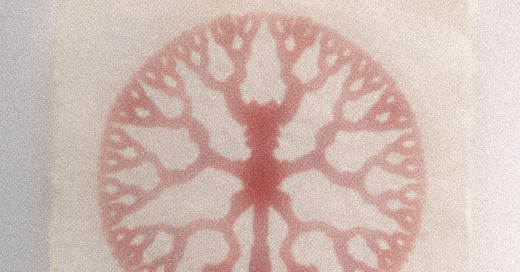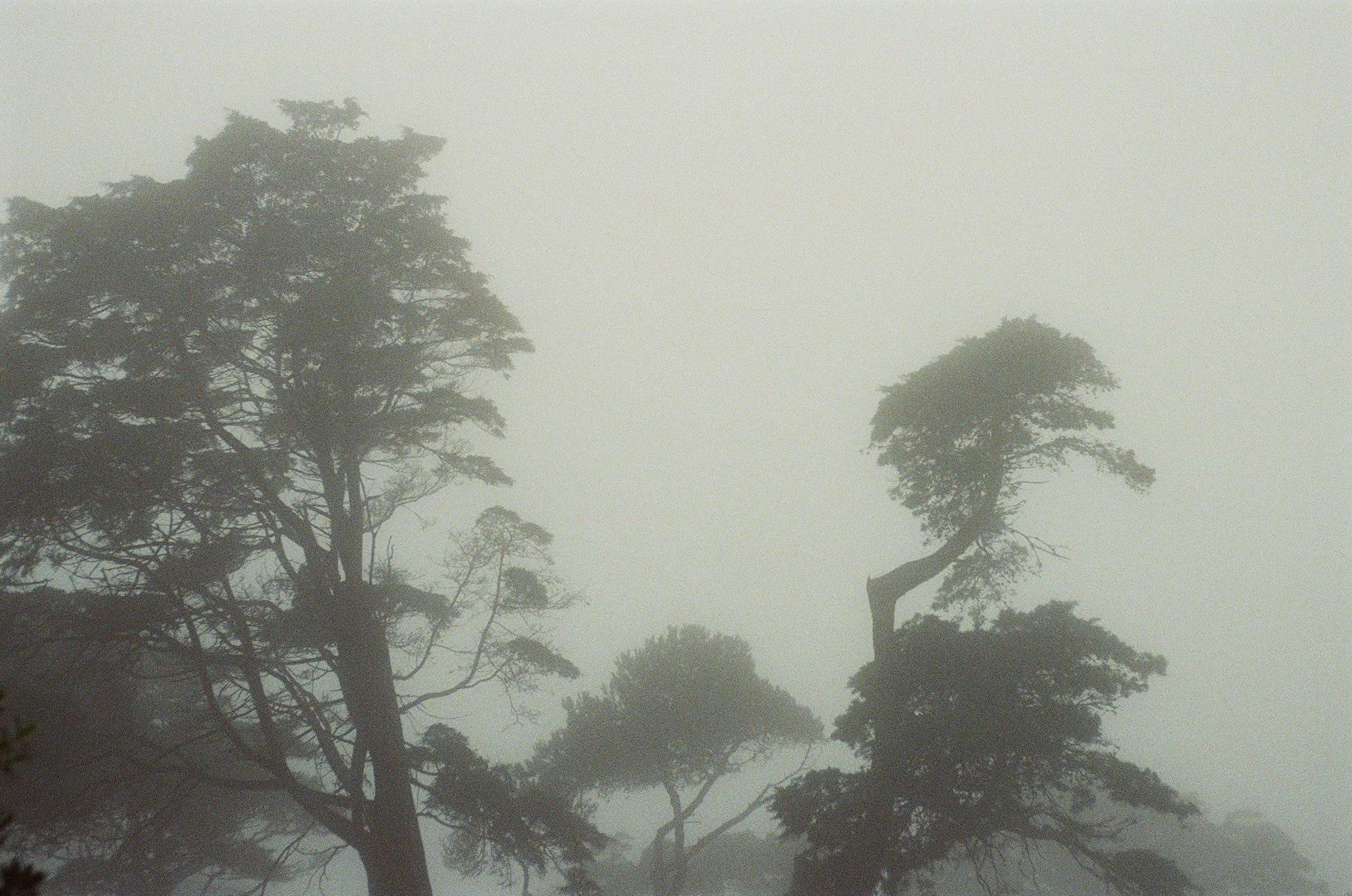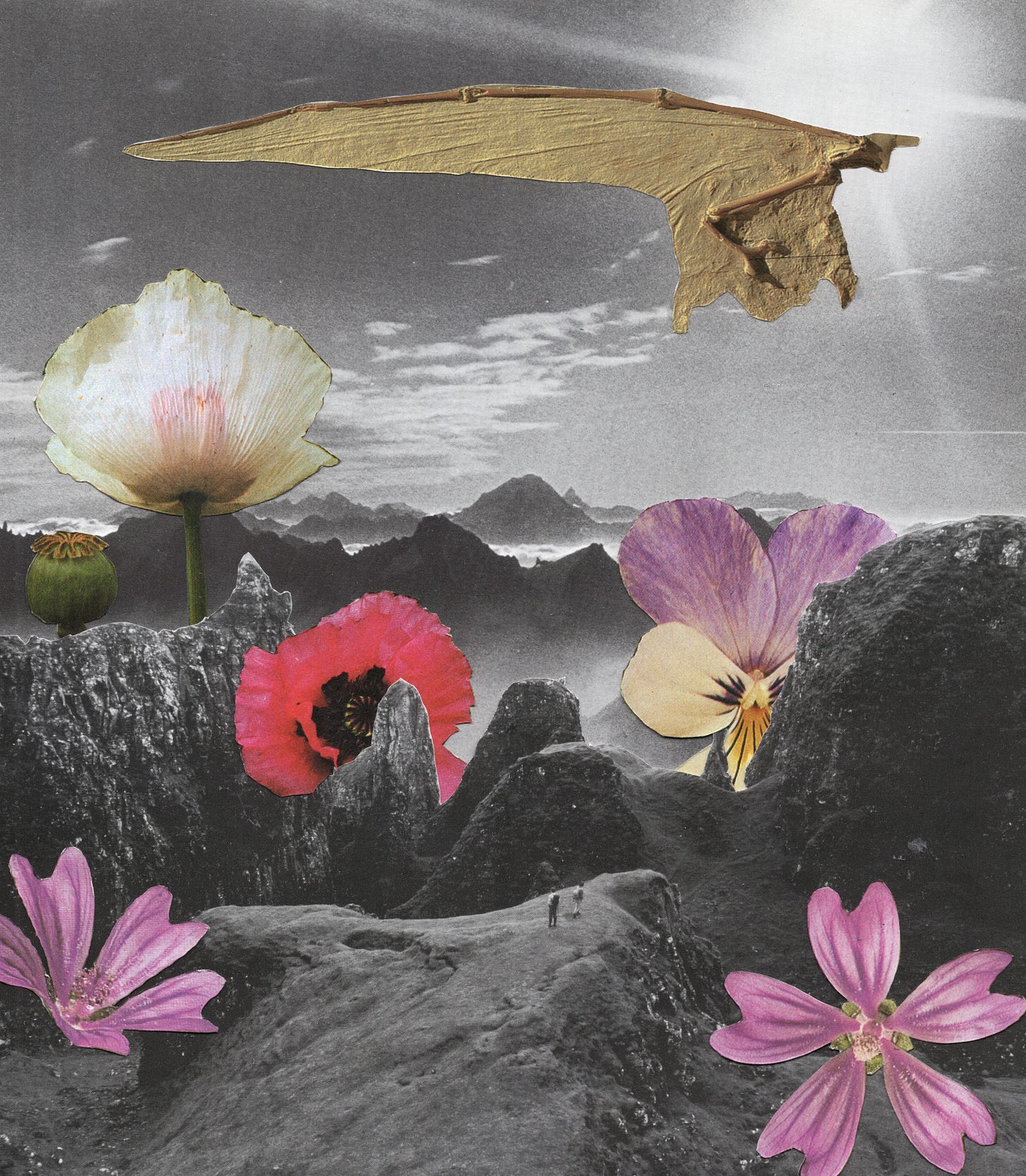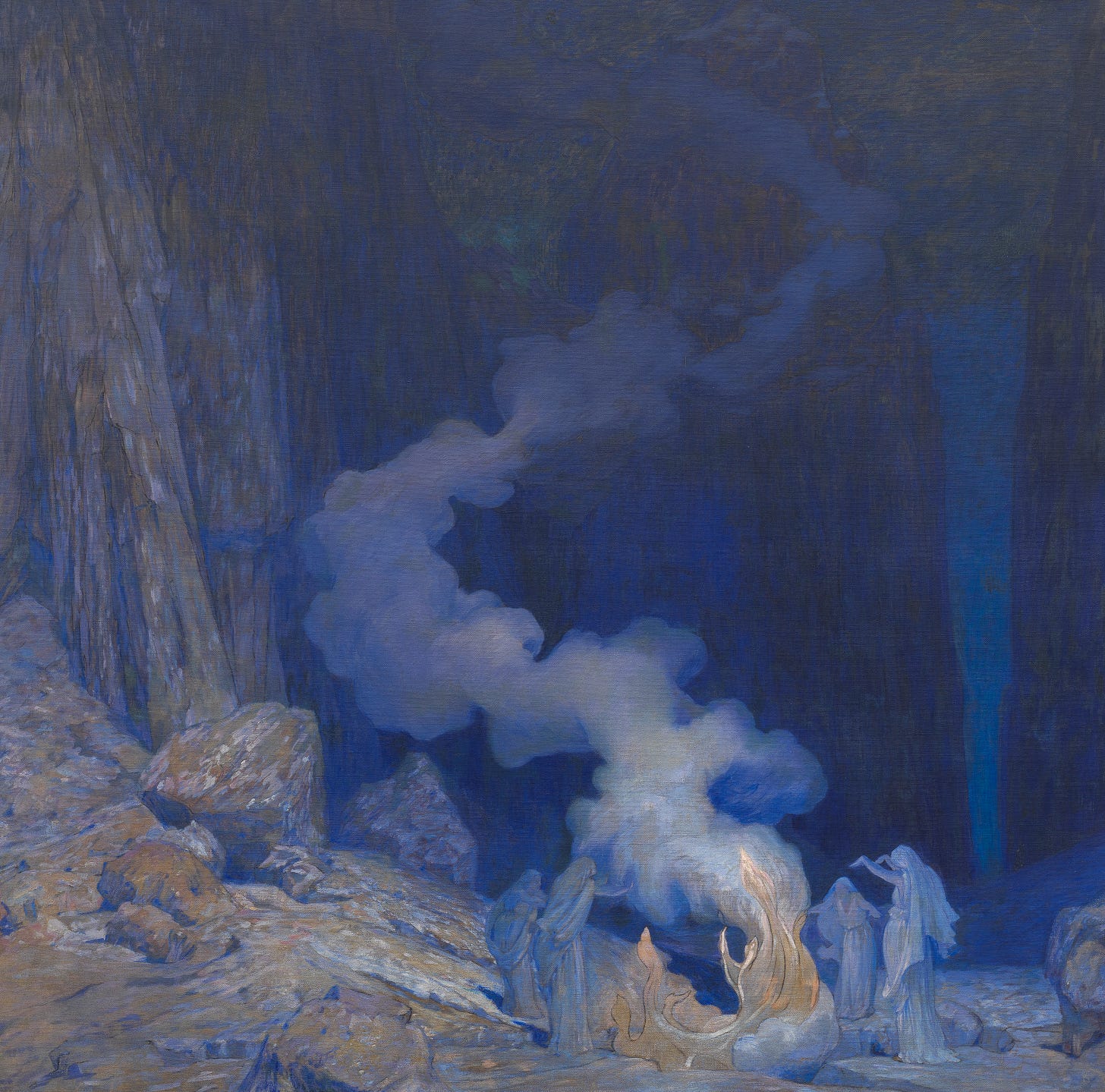Magic Kills Industry
Communing with the Mystique: Creating Self-Expression Practices that Delineate the Unknown
“All that we have learned in this world is partial knowledge, and when this is uprooted by another point of view, then we have knowledge in its completed form. That is called mysticism. Why is it called mysticism? Because it cannot be put into words. Words will show us one side of it, but the other side is beyond words.”
— Hazrat Inayat Khan , “The Mysticism of Sound and Music”
At the end of December 2022, I took a walk in the Botanical Gardens of Edinburgh. I was alone.
It was a cold and sunny day. I knew these gardens well— they used to be my hiding place when I lived in Edinburgh four years ago. I met my known trees through a winding walk around the grounds.
The curvy long-needled pines, the elder redwoods gathered in an eternal circle. The way light brushed through the branches of the evergreens— I could almost inhale it. My heart was swelling up, my eyes were swelling up. I could hear a voice within. I sat down on a bench and started writing.
I felt that in 2023 my soul and the greater life were calling me into the hands of the feminine, the mystique. It’s hard to write about something I can only experience without words.
(I don’t want you to recoil when I write feminine. I am not approaching this from a gendered place, but from a dual energetic perspective.)
It’s a feeling that permeates my body with warmth and a deep connection to the invisible. A yearning for a connection with this essence, with the mystique, with the obscure, hidden, sacred.
As I enter into a conversation with the unknown, lost-yet-familiar, I somewhat enter into this conversation as my essence. Not as my identity, not as my ego. I am a student of the language of trust in my own perception.
The world calls us into the invisible, my life calls me into the invisible. And there is something about the bravery to trust your own subtle perception, your dreams, your visions—without a need to be validated by the external reality—is what allows that conversation with the unknown to unravel.
Opening up to this conversation invites us to meet that stranger part of us that whispers and calls us to traverse between perceptual realities. It’s a part of us that articulates sparingly and in intervals, yet always true—unburdened and unfurling in truth.
There is something about the feminine that encompasses everything that is unknown. It will not reveal prematurely, it will ask you to grow and sharpen your senses that go beyond a physical validation of reality. Yet, it will ground you in both, the physical and the psychic.
The ancient, timeless feminine will obscure the certainty we have known. She will expose us to experimental visions, senses, channelings, and ideas— vulnerable to the timing and circumstances of their gestation within us.
Can we contain and carry these visions long enough, can we nourish them long enough so they reach the threshold and become materialized?
The creativity here is not a generative act of means to an end, but a sacred vessel to encapsulate something that wants to be materialized.
Art and craftsmanship become practices through which we can practice this communion.
Earlier, in an essay about creativity denial, I wrote about painter Agnes Pelton, working her way into the desert landscape, as a Transcendentalist painter of our age. How did she trust her process and what was coming through her? “Working under the deep influence of Eastern and Western mysticism, theosophy, and Jungian insight, the painter dedicated her life to artistically exploring the intersection of the living world’s symbolism, animism, and transcendentalism.”
By now, many of us know the story of Hima af Klint, a Swedish paintress who lived more than 100 years ago, channelling over a thousand paintings within her lifetime. Paintings with their colour-coded meanings, a series of increasingly abstract imagery, guided by a higher power. On her deathbed, she left paintings to her nephew, asking him to keep her paintings hidden from the world for 20 years. Because “the world is not ready to see them yet”, Hilma said. The paintings were first exhibited in the 80s, 40 years after her passing.
The world was not ready to temper with the mystique.
Now, everyone is copying Hilma.
But what they are missing is the communion with the invisible that Hilma had. This is where all of her art came from. What these artists are missing is the process, which was imbued with mysticism.
“It’s easier to make a woman into a crazy witch than change art history to accommodate her. We still see a woman who is spiritual, as a witch, while we celebrate spiritual male artists as geniuses.”, says Halina Dyrschka, the German film-maker, who made a film about Hilma af Klint Beyond the Visible.
Devotional practice becomes a prolific channelling, to which many artists have dedicated their lives. Each devotional practice tells a story and becomes a pixel, a thread in a greater imaging of the unknown. This is how mystics, artists, and storytellers, build a negative mould in which the invisible can take shape.
Paradoxically, to come closer to the invisible, we devote ourselves to creating the visible. The shape our creations take is the negative space that surrounds the mystique. From there on, we can only infer.
Joshua Schrei, in his podcast episode For Intuitives (Part 2) draws upon civilization’s eradication of mysticism. Wherever civilisation appears, the mystical is banished. Erased. Burned, destroyed on purpose.
Today we can work towards reclaiming that communion with visioning. Communion with the invisible will never be found in popular culture, ready to be seen by thousands of glimmering eyes on the screen. It will never be a 5-step process.
Those who create and share their outputs—we will see the byproduct of their communion with the invisible: the art process, the prayer, the incantations, the tempering, the stories of mystical encounters—if they were real, they will only be shared in sparingly. We will see it in the manifestations of those experiences as (art) pieces that can take shape in this world in a material form (including music and sound).
Today this visioning is very different, it will take different forms because our society has decontextualized its relationship with the invisible over hundreds of years. Today, we need to seek to find and create our own contexts, our own ecologies for this work.
“Magic kills industry” — Francis Bacon, 1870
Let’s remember the witch hunts of the Middle Ages. Let’s remember that capitalism was established by eradicating mystery—eradicating witchcraft, women, birth control, sexuality, and the body as a vessel of mysticism.
The eradication of the unexplainable, of animate, of alive was the prerequisite for the forces that now govern our Western societies.
It took hundreds of years to wipe out animist societies, because mysticism, at the time of the late Middle Ages, threatened the basis of social structure. Witch hunts took hundreds of years because the animist worldview was so deeply rooted in the human psyche. Animism and magic were things that kept disrupting the capitalist regime.
Today, magic has become coopted in many spaces, and in some cases, it’s become a part of industry. Magic does not cause friction in the capitalist system (or it does and we don’t hear enough about it).
“The revival of magical beliefs is possible today because it no longer represents a social threat. The mechanization of the body is so constitutive of the individual that, at least in industrialized countries, giving space to the belief in occult forces does not jeopardize the regularity of social behaviour. Astrology too can be allowed to return, with the certainty that even the most devoted consumer of astral charts will automatically consult the watch before going to work.”
— Silvia Federici, Caliban and the Witch: Women, the Body and Primitive Accumulation.
When I asked David Abram (during the Emergence Magazine course) how long it would take us to collectively re-animate our minds, given the hundreds of years of animacy being suppressed in our societies, he said: “From a magician’s perspective—it takes a moment. It’s just when the moment is ripe and ready. That’s something that can spread like a bloody contagion through the world, infecting everyone. We never truly lost animism, to lose it—our heart would stop beating.”
“The shape our creations take is the negative space that surrounds the mystique.“
Our map of the invisible can only be drawn when we put our creations onto the map. I cannot point to the invisible, I can only look at the shapes I already see that surround it.
Aren’t our jewellery and clothes something that surrounds the mystical? The negative shape of our clothes and adornments is inhabited by our bodies.
An artist jeweller is a goldsmith, working with alchemy, base elements of the earth - wielding them into adornments. Graced with ancient practices, and their own specific meanings. Each mineral and stone has its own story, resting in the earth for millions of years — finds a way to hold onto your ear or to be a tiny crystalline shield above your heart.
The jeweller tells a story not only of minerals but also of the practices of the ancient, lost, forgotten—yet powerful in their crucifying belief in the ritual of adorning.
Isn’t mysticism a practice?
Isn’t continuous devotion to creating beauty imbued with the unknown, a practice of mysticism?
I want to share some examples of contemporary jewellers who I see as modern-day mystics in their own right— Alexa de la Cruz and Savannah King.
Savannah King is a fine jewellery artist based in Topanga, California. She leads a Sacred Adornment Mystery School, which will be opening its doors in September. She runs an account Golden Practice where she explores ancient gold-smithing practices around the world.
What does mysticism mean to you in your practice (especially now that you have opened the doors to the Sacred Adornment Mystery School)?
Savannah King: My desire to create comes from a place of vision and conversation with spirit. I open myself to be a vessel for these energies to move through and create from there. The gift of mysticism in art is that it can open a door to the inherent connection and divinity in each of us.
When did you feel a call to go in this direction and how did you start answering that call?
Savannah King: I have always had a strong intuitive connection to nature and the esoteric but it wasn’t until I was in my early thirties that I shifted my lifestyle to be in devotion to it. There were a series of initiations that redirected my life path. It was both challenging and beautiful.
I tried many creative mediums from playing music to neon light sculpture but when I walked into the jewellery studio it was a kind of remembrance. I knew this was what I’d done in many past lives and what I was meant to continue now.
Savannah later expands:
One of the aspects that is so important with adornment, is its ability to create consciousness on the body, to create a ritual space on the body. We have the opportunity to curate the energy in our field. Often times it is to attract, and other times it is to repel, it can guide our conversation with spirit. The practices that I am talking about (of attracting and repelling) were special for healers and shamans throughout the history. Especially because these are the people travelling between realms.
Creating a devotional practice
To whom are you devoting your practice, your art?
Artistic visioning becomes permanently embedded in the greater ecology of society, even if society is the place where those visions come to die.
I’ll say it again.
Artistic visioning becomes permanently embedded in the greater ecology of society, even if society is the place where those visions come to die.
This visioning changes the lining of the womb—the lining of the societal matrix we attach to and grow from.
There will be new souls born into this Earth, and the societal matrix soil will be different. And they will feel that difference because your creative visioning has been here, working.
The right seed has a way of changing the soil. The seed turns into a plant that has a very different relationship to the soil, it attracts different species, different minerals, and eventually — changes the weather patterns.
Through creation, we move closer to the veil, sometimes through it. But we are always working with the unknown and a feeling of life. Life behind all of the mystery. We are interested in mystery because there is life, bustling behind it. A story of life.
For us to be able to hear further than the first layer of voices (inner and outer), we must reach into our abilities to hear spherically, with all of our senses of the interior self. Emmanuel Vaughan-Lee calls it “driving blind with big ears”. Creation from that place becomes very different.
In the end of 2023, December solstice I paid a visit to the Edinburgh Botanics again and made a ritual of my own, for the invisible.
I stood in the circle of redwoods. I went around each tree, touching its bark with my palm and saying thank you.
I set my back into the soft redwood bark. In front of me, I laid out branches and seeds I found while wandering around and sat in deep meditation.
I felt as if I could sit under that tree forever.
Practice
To dance with the mystique is to intentionally leave room for the unknown. And continuously move towards a place where the veil is thin.
I invite you to go on a meditative walk or sit in a meditation. And to invite that communion, invite the deep interior listening. Who and what wants to be listened to and made visible in this reality?
Consider these questions in your meditation or journalling:
Where in your art is that tempering with the unknown? What spaciousness is given to your projects?
What value do your projects absorb, when you are approaching them with your practice being sacred and an offering to something larger?
Were your creations different if you created that space for communion with the invisible?
What can be channelled in the space of deep listening, in the absence of other sensory inputs?
How can you create a space for deep listening?
What is your way of feeling the invisible and communing with the mystique?
I would love to hear your reflections on this practice—feel free to email me, DM or share in the comments. 🤍
“All beauty in the realm of nature, art, or personality is silent music. Every soul has been born on earth to love what is beautiful, and beauty is its own sustenance.”
— Hazrat Inayat Khan , “The Mysticism of Sound and Music”











Loved this piece. Two things comes to mind:
1) this short film about Alice Coltrane who seemed to have embodied and engaged with these ideas so beautifully https://psyche.co/films/with-quiet-words-and-devotional-music-alice-coltrane-sought-transcendence
2) Sister’s Hope just outside Copenhagen… have you been? I’m hoping to soon. I’ve heard amazing things and it seems like a space for this sort of exploration. https://sistershope.dk